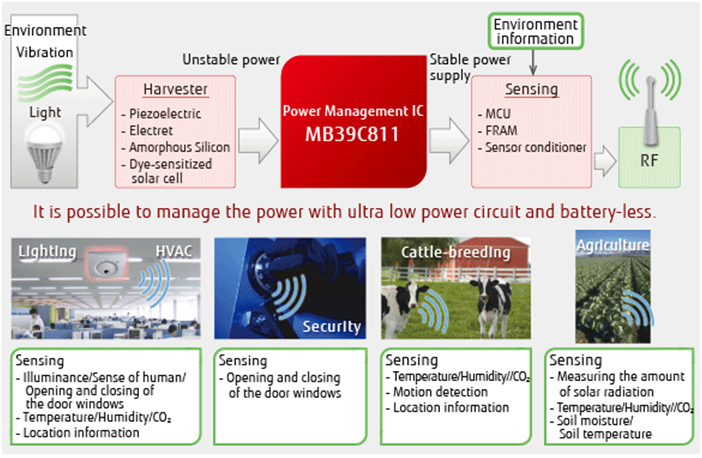Energy harvesting is the process of capturing and converting ambient energy – light, vibration,wind, kinetic, thermal and radio waves – into electricity for a wide range of applications (wireless sensor networks, internet of Things IoT, …)
Energy Harvesting is defined as the process of capture, accumulation, storage and conditioning of wasted energy from surrounding environmental sources.
PMICs – Power Management Integrated Circuits
MB39C811 from Spansion http://www.spansion.com/Products/Analog/Energy-Harvesting-PMICs/Pages/pmic-eh.aspx
power generator from vibrations and solar-cells.
There are numerous sources of free energy available to harvest. Photoelectric power is perhaps the best known. Whenever light of the right wavelength falls on a photo cell, it generates electric power. The light source can be natural (the Sun) or artificial, so some amount of photoelectric power can be had essentially anywhere there is light enough to see by.
Another source that is readily tapped is the energy of motion. Kinetic energy harvesters translate rotary, vibrational, translational, and other kinds of motion into electric power by means of piezoelectric or magneto-inductive generators. As long as the motion is taking place, power can be harvested.
Using the Seebeck effect, any kind of temperature differential can be used to produce electric power. Wherever there is a heat source that exceeds ambient temperature, an energy harvesting system can extract power.
Seebeck effect, production of an electromotive force (emf) and consequently an electric current in a loop of material consisting of at least two dissimilar conductors when two junctions are maintained at different temperatures. The conductors are commonly metals, though they need not even be solids. The German physicist Thomas Johann Seebeck discovered (1821) the effect. The Seebeck effect is used to measure temperature with great sensitivity and accuracy (see thermocouple) and to generate electric power for special applications.
For instance, the relatively small amount and irregular availability of harvest power can be handled by accumulating power over time and using it to operate the IoT device only occasionally.
This can be done by using an energy storage device such as a rechargeable battery or a supercapacitor to store enough power to enable a short burst of activity from the IoT device, which then goes to sleep or shuts down until there is enough power to activate again.
http://batteryuniversity.com/learn/article/whats_the_role_of_the_supercapacitor
Maximum power point tracking – MPPT
The function of a MPPT is analogous to the transmission in a car. When the transmission is in the wrong gear, the wheels do not receive maximum power. That’s because the engine is running either slower or faster than its ideal speed range. The purpose of the transmission is to couple the engine to the wheels, in a way that lets the engine run in a favorable speed range in spite of varying acceleration and terrain.
.
Powering the Internet of Things From Ambient Sources
http://www.digikey.com/en/articles/techzone/2013/oct/powering-the-internet-of-things-from-ambient-sources
Energy Harvester Produces Power from Local Environment, Eliminating Batteries in Wireless Sensors.
Components
Maxim Integrated MAX17710
Linear Technology LTC3108
Spansion MB39C811
EFL700A39 from STMicroelectronics, EnFilm solid-state lithium thin-film battery, rechargeable , 220um x 25.7 mm x 25.7 mm, 3.9V nominal voltage and 0.7 mAh capacity. Long cycle life allowing some 10 years of use if charged once per day. The price is $30.00 per unit for orders of five units minimum.
Boards / Development boards :
EH300/EH301 EPAD® Energy Harvesting
Silicon Labs
Cymbet CBC915
Cymbet EnerChip™ and Energy Processor Evaluation Kits
Texas Instruments BQ25504
.
.
.
.
.
.
.
.
.
.
.
.
.
.
.
.
.
.
.
.
.
.
.
.
.
.
.
.


